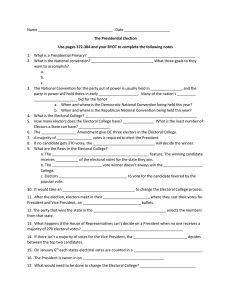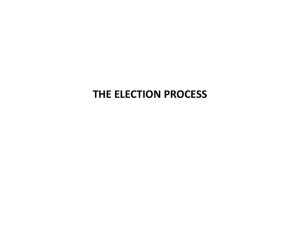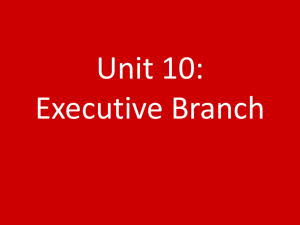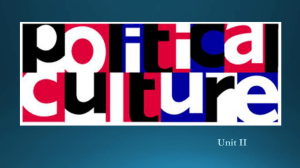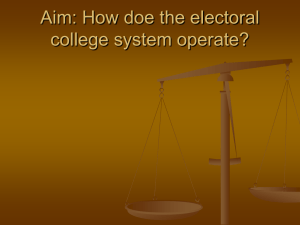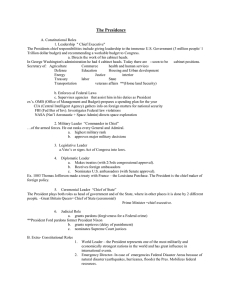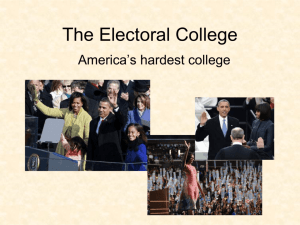Electing the President: 8 Steps to the White House
advertisement
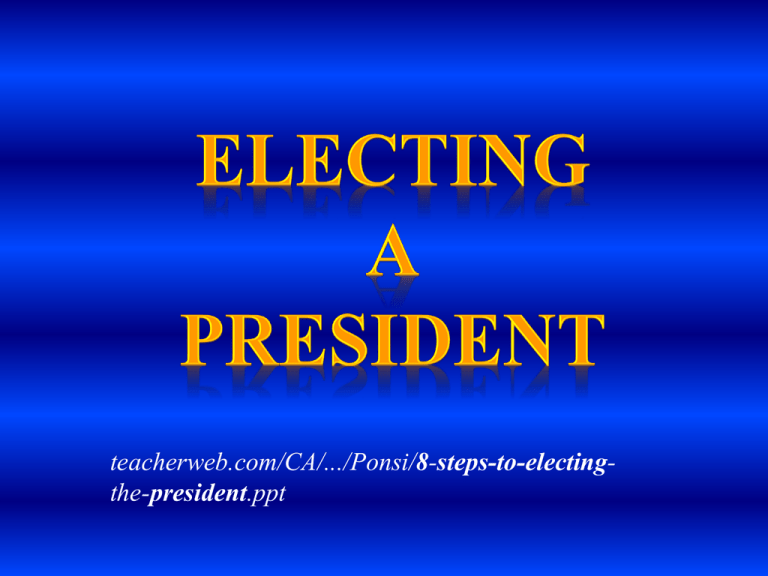
teacherweb.com/CA/.../Ponsi/8-steps-to-electingthe-president.ppt Step One: Organize and Planning Official Constitutional Requirements Three requirements Age: 35 Citizenship: Natural born citizen Residency: Resident of US for last 14 years STEP 2: State Caucuses and Primaries • Caucuses – Purpose: Small meetings, where people come together to select delegates – First state: Iowa – Importance: as we have seen, Iowa can give a huge boost to a candidate (Obama) or force people out of the race early (Biden and Dodd)) • Primaries – State elections with in a party to get delegates support at the national convention • 3 kinds: open, closed and binding – First state: New Hampshire – Importance: weeds out candidates, proves who can win and where STEP 3: Win Nomination at Convention • • • • • • Purpose of convention: Choose party’s candidate Where do we hold the convention: Big electoral state Why: Get media exposure for party and candidate What is the Platform Committee: Writes rules for convention and writes the party’s stance on current issues (that is voted on by delegates) Significance of the Keynote address: kicks off convention, sets tone and exposes an “up and coming star” of the party Selection of the Nominee: as many ballots as it takes to get the majority support of delegates Acceptance speeches: Accepts Picks the VP running mate • • Call for unity: get the party faithful fired up for the Fall election STEP 4: Campaign against other Parties • Formal start of the campaign : Kick off is the Labor Day weekend: the beginning of September; 8 weeks to package the candidate • Time constraints: Campaign needs to decide its strategy for winning the elections; where to campaign, how to spend resources; swing states are states that can “swing” the election because they have more electoral votes or independent voters that can be swayed to vote for either party • Use of Media: Decide how and where to spend money; ads, radio, talk shows, TV • Debates: A candidate has to decide if (s )he will participate; if so when, where, the format. STEP 5: General Election • Day America votes: Presidential elections are always the first Tuesday after the first Monday in November; every four years; always in even number years • Voting: goes on all day and polls close at 8:00pm • Exit Polls: gets info about how people voted as they exit the polling place • Media Coverage: As the east coast polls close, broadcasting the outcome can affect the west where the polls are still opened STEP 6: Electoral College • Electoral System: the people who really elect the president • Number of electoral votes needed to win: 270 • Electoral votes by state: number of representatives and+ 2 senators = electors • Vote: Each states sends electors from the winning party to the capitol to vote for president on the first Monday after the 2nd Wed. in December • Plurality vs. majority: Most popular vote vs 50% +1 • Problems with the system: Popular vote doesn’t win; electors aren’t obligated to vote any one way; messy system if no one gets 270 electoral votes STEP 7: Transition Period • Lameduck President: Outgoing president • President elect: Briefed by appropriate government agencies • Secret service protection: Full time police protection for president and family • Transition: Cabinet selected, inaugural address written; starts putting the staff in place. An office and staff is provided by the government STEP 8: Inauguration • When: January 20th • Oath of office: Sworn in by Supreme Court Justice; gives the inaugural speech to inspire the country, Parade, if weather permits, the president and family walks down Pennsylvania Ave., assumes the job • Inaugural Ball: There are many parties that take place that night; corporate sponsors; the president and VP and spouses go and make an appearance at all of them.



